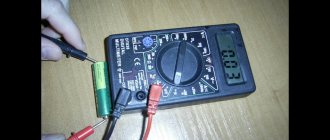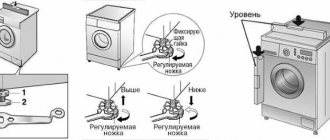Batteries are characterized by a certain voltage and fixed current. These two parameters change under the influence of external physical factors. Gradually, the charge level in the device decreases, and over time, such a battery is completely discharged. Therefore, information on how to learn how to measure the charge level of batteries and batteries is important. This skill is also useful for analyzing the state of charge of batteries that have not been used for a long time.
How to test a battery with a multimeter?
It's no secret that the performance of modern cars directly depends on the condition of the battery. After all, the time for engines that can be started by turning a lever has long passed, not to mention the fact that for the functioning of modern electronic systems responsible for driving safety, navigation, etc. power supply required. Accordingly, maintaining the battery in good condition is quite important. Unfortunately, methods for diagnosing it are unknown to many car owners. Therefore, in this article we will tell you how to check the battery with a multimeter.
A multimeter is a universal electrical device that any driver should have with him. It can be used to measure many important parameters that indicate battery performance.
- How to check battery charge with a multimeter? How to check battery voltage with a multimeter?
- Checking the car battery capacity under load
Find out the capacity of a smartphone using a USB tester
A USB tester is essentially the same multimeter, only designed for modern devices. Unlike a conventional device, it can also measure the battery capacity of a mobile device.
The device is simple and easy to use and connects via a USB port. It is capable of measuring current and voltage and displaying the received data on the display. Counts the amount of energy passing through it, which is used to determine the battery capacity. The device stores all its calculations in independent memory blocks; you can always return to the data and double-check it. Unneeded information can be deleted using the Reset Content key.
How to measure battery capacity with a tester:
- Completely discharge the battery under test.
- Set the value of the active memory cell of the tester to 0.
- Connect the charger and the desired battery in series.
- When the device is fully charged, the tester will show the battery capacity level.
You can do the complete opposite: first fully charge the phone, and then measure the time it is fully charged.
USB Battery Capacity Tester
If less than 50% of the original capacity (declared by the manufacturer) remains, it is better to change it. This should also be done if its appearance leaves much to be desired - there are swellings and deformations.
You can take measurements in various ways, but according to reviews and opinions on various forums, everyone - including mobile applications - has an error, which means the result will be inaccurate.
The most reliable measurement is via a USB tester. However, it is advisable to purchase this device only if you intend to use it regularly. It doesn't make sense for one or two batteries. It’s good that measuring capacitance is not its only function.
Communication with mobile devices is maintained constantly, which is possible through cellular stations and a small battery located inside smartphones. Moreover, after intensive use, any battery wears out. Consequently, the question arises: how to check the phone battery with a multimeter for performance and whether it has failed before the expected time?
How to connect correctly
In such a question, how to check ammeters with a multimeter, you need to be guided by the recommendations below:
- Calculate the range for measuring indicators. The battery has 1.5V, 7.5V and 12V. The value is set slightly higher than normal. This will be a reserve that will prevent damage to the device.
- Correctly determine the direction of the current, i.e. polarity of the terminals on which the measurement will be performed. The generally accepted designations indicated on the body are taken as a guide.
- Proper connection of the probes is necessary. Black - negative, placed in a general type socket called COMMON (COM). Positive - installed in the red connector.
The device is easy to operate
. Next steps:
- The device is adjusted to the desired measuring range.
- The value is set 10% higher than expected.
- If the indicator is unknown, then the maximum is taken as the extreme value.
- The probes are installed according to the scheme corresponding to the type of measurement being performed. Red to connectors where current, voltage or resistance are measured. Black to common connector.
- The probes are brought to the device being tested or the power supply network. Red is placed on a plus, black on a minus.
- It is necessary to evaluate the obtained indicators. It may be necessary to initially adjust the position of the pointer (“to zero”) to make the information more reliable.
Types of batteries
Portable batteries differ both in operating principle and in appearance. Main types of batteries:
- Finger (size designation AA);
- Pinky (size AAA);
- Large cylindrical (size D);
- Medium cylindrical (designated C);
- Krone type (shape - parallelepiped);
- Flat (shape - flattened parallelepiped).
All cylindrical types of charge storage devices have an operating voltage of 1.2 to 1.6 volts. The voltage of Kron type elements is 9 V, and flat 4.5 V. The performance of the element depends on the load to which it is connected.
In low-power devices, a decrease in battery voltage does not affect performance for a long time, but in powerful devices, such as cameras or electric motors, even a slight drop in voltage will cause equipment failure.
Batteries also differ in the type of internal filling. The following types are distinguished:
- “Salt”, “dry” - carbon-zinc. This type of battery is the cheapest, but it discharges the fastest and does not work well in cold conditions and with powerful loads;
- HeavyDuty - zinc chloride, similar to the previous type, have a slightly larger capacity;
- “Alkaline”, alkaline - work better at low temperatures and hold a charge at high current, but discharge quickly;
- With the use of mercury - high-capacity, they are difficult to quickly discharge, however, due to the danger of mercury, they have fallen out of use;
- Using silver - they discharge slowly and work well with a powerful load, but are expensive;
- Lithium - have the highest capacity and the smallest weight among similar ones. Long shelf life. High price.
Also, all batteries are divided into two types: primary, that is, galvanic cells and secondary, that is, rechargeable or rechargeable. The former are usually cheaper, but must be disposed of after use. The latter often have a lower capacity, are more expensive, but can be recharged with a charger.
AC current measurement
Situations often arise when it is necessary to check the electrical network of a building. This is also the case with a regular electrical network in apartment buildings. Knowing how to measure the current strength with a multimeter in an alternating network, you can make minor repairs to the wiring at home.
The electrical outlet should also not be tested without a load . The best load for an AC network would be an incandescent lamp. To take measurements you need to do the following:
- Install the red probe into the socket of the device, marked with the inscription, A (NA), leave the black one in its proper place;
- Select AC current measurement mode and signal level;
- Connect a load in series with the measuring device to the socket;
- The effective current value will be displayed on the device screen, and the lamp will begin to glow.
Since the voltage in the network has a variable sinusoidal shape, the measuring device shows the effective value, which is 1.41 times less than the amplitude value.
Using the proposed method, you can check any variable circuit, including transformers, inductors, asynchronous and synchronous motors.
Connecting a multimeter
First you need to turn off all devices that can be powered by the battery. To carry out measurements, the multimeter is connected to the open circuit. To get such a gap, remove the wire from the positive terminal (you can also use the negative terminal) of the battery. Then connect one contact of the ammeter to the plus (or minus) of the battery. And the second contact is connected to the removed wire.
Do not connect measuring instruments to the plus and minus on the battery, otherwise a short circuit will occur and the fuse in the multimeter will blow.
After connection, a number will appear on the device screen that corresponds to the current consumed by constantly switched on electrical appliances. If the permissible current leakage in the car is lower than the measurement result, you need to look for the cause further.
Advantages and disadvantages of the device
Let's list the advantages of digital devices over analog ones:
- There is no need to set "zero".
- Increased accuracy.
- Auto-tuning.
- High input voltage.
Digital and analog instrument
- Dependence of display brightness on charging.
- As the meter heats up, errors follow.
- Ultimate voltage.
- High price.
What parameters can you check?
Using this electrical characteristics meter, you can find out the battery capacity, voltage (potential difference) between its poles, internal resistance, and leakage current.
How to measure voltage
Measuring the value of this characteristic on a rechargeable power source using a multimeter is carried out as follows:
- The meter switches to the DC voltage measurement range up to 20 V;
- The tips of the probes are applied to the power supply poles (terminals) of the same name;
- After a few seconds, the current battery voltage value is displayed on the display.
On a note. If the “–” sign is displayed on the display next to the numbers, this means that when connecting the clamps or probe tips, a “polarity reversal” occurred: the probes are applied not to like poles, but to opposite poles (the negative black probe is applied to the positive pole, the red positive one is applied to This situation does not pose any particular danger, but for normal operation of the meter it is better to avoid it and ensure that the polarity of the probe connections is observed.
How to measure capacitance
You can find out the battery capacity as follows:
- The battery is fully charged, after which a load with a previously known current consumption, for example, an incandescent lamp, is connected to it;
- The time during which the load will operate normally is noted;
- At the same time, the probes (clamps) of the multimeter are connected to the poles, switching it to the mode for measuring direct voltage in the range of up to 20 V. This operation is necessary in order to monitor the level of drop in the potential difference, turning off the load at the moment when the power supply is minimal acceptable value of this characteristic.
- The actual value of the characteristic is found by making a simple calculation: multiplying the current consumed by the load by the time of its normal operation from a fully charged battery. The result obtained is expressed in Ampere hours (A*hour, Ah).
In addition to a multimeter, the capacity of rechargeable elements is measured using a device such as a tester.
How to check internal resistance
To check the internal resistance of the battery, perform the following manipulations:
- A load is connected to the battery: a light bulb, a motor or some kind of tool;
- Let the load run for 5-10 seconds;
- Measure the supply voltage (U1);
- Disconnect the load;
- Re-measure the voltage at the battery poles (U2);
- Find the difference between the two values U1 and U2, then divide it by the nominal potential difference declared by the power supply manufacturer, then convert the result into a percentage. If, in percentage terms, the value obtained based on calculations is less than 0.4%, then the internal resistance is normal.
Elements with an indicator exceeding this value are considered unsuitable and even dangerous for further use.
How to check leakage current
Leakage current is a dangerous, undesirable phenomenon for any rechargeable power supply. Checking its presence on the car power source is as follows:
- Turn off the ignition;
- All consumers operating with the ignition off are turned off: radio, security system;
- Disconnect the negative terminal of the power source;
- Switch the multimeter to the mode for measuring direct current with a power of up to 10A;
- Using alligator clips, connect the positive probe of the multimeter to the pole of the same name;
- The negative probe is connected to the negative terminal removed from the battery pole;
- A sign of the presence of leakage current will be a changing number on the meter display: the higher the value displayed on it, the higher the leakage current and the spontaneous discharge of the element in idle mode.
Checking the laptop battery capacity
There are ways to find out the capacity of a particular device, using, for example, a special portable tester for computers. However, it is very expensive in cost, about 30,000 rubles, and such devices can be found mainly in service and repair centers.
People well versed in electronics know how to determine the capacity of each of the 18650 lithium-ion batteries that make up the power supply unit of the laptop. They can skillfully disassemble the battery, measure the voltage at the poles using a voltmeter, and check the battery capacity with the popular “people’s charger” Imax B6. However, this technique requires certain skills and abilities, in particular, opening the computer battery pack. Therefore, it is better for beginners to use special programs and applications.
At home, it is usually recommended to check your laptop battery using the AIDA64 application. It needs to be downloaded and installed on your computer. Then fill the battery completely, disconnect the laptop from the network and run the program. In the window that appears, find the “Power supply” option, click on it and view all the main parameters of the current state of the battery: whether it works well or poorly, what its capacity is and the degree of wear.
When using any laptop using a high-capacity 18650 battery, it is important to remember that it must first be charged from the mains and then completely discharged. If the computer is constantly plugged into a power outlet, without discharging the battery, its actual capacity drops, and it can very quickly fail.
Is it possible to charge the battery at home?
It is advisable to charge the battery in non-residential, well-ventilated areas. If you still had to charge the battery at home, it is better to do it on the balcony. The fact is that during the charging process, the battery releases sulfur dioxide, which is dangerous to human health, as well as oxygen chloride compounds. Such volatile substances may cause illness. It is necessary to monitor the charging duration and the state of the electrolyte. Do not allow it to “boil”, as this can significantly reduce battery life. The charger current during charging should be minimal. Remember, it takes 7-8 hours to fully charge a 60 amp battery.
Specialists from the official service centers of FAVORIT MOTORS Group provide a full range of services for servicing and repairing cars of all brands. Qualified technicians will quickly eliminate any faults in electrical equipment and conduct a thorough diagnosis of all systems of your car. Contact the professionals!
How to check
Before you start checking the voltage, you need to turn off the car's ignition. It is not difficult to measure the voltage and other parameters of a battery with a multimeter; working with the device requires minimal knowledge in the field of electronics. The battery itself must be disconnected from the terminals or removed.
Battery voltage
To check the voltage, the device must be switched to DC (voltage) mode, and the rotary switch set to 20 V. The multimeter has two probes: connect the black one to the negative terminal, and the red one to the positive terminal. A number indicating the DC voltage will appear on the device display. If the wires are the same color, you need to carefully inspect them for special markings.
After removing the voltage, you can obtain the following information about the condition of the battery:
- A charge above 90% corresponds to a value of 12.7V (sometimes 13.2V). This means the battery does not need to be charged.
- The voltage range from 12.1V to 12.4V indicates 50%-60% discharge.
- If the values fall within the range of 11.6V – 11.7V, then you need to charge the battery as soon as possible.
As you can see, you can check the battery with a multimeter and measure the voltage if you have no experience.
Battery capacity
To measure the battery capacity, you will have to perform a test discharge of the battery. The battery must first be charged (fully), this point is easy to determine - use the instructions given above to measure the voltage. After this, a load of known power is connected to the battery - an incandescent lamp will do. Having marked the beginning of the study, stop it when the discharge occurs by 50%. Disconnect the light bulb and calculate the capacity: to do this, you need to multiply the current value when the light bulb is connected and the discharge time. It must be expressed in hours, and the current in Amperes. If the result is close to the nominal value, the battery is OK.
Checking the battery capacity of a screwdriver
You should check the battery capacity of a screwdriver by first determining the current voltage readings. The readings are taken while the battery is charging. Using a multimeter or voltmeter, 30 minutes after connecting the battery to the network, the first voltage reading (U) is taken. It should be 13 V. Then after another half an hour - the second indicator, normally it is 13.5 V. The voltage increases gradually, in two hours it increases to approximately 14 V, and if the battery is fully charged - 17 V.
After this, the tester measures the voltage between the poles. It is important to consider that the indicator obtained from such a measurement is the number of “rest” or “idling”, without load. Working U is usually 14.4 V (for 12 battery jars), and “idle” is 17 V.
If the U value is lower, it means that some parts of the battery may have failed, or the battery may not have been fully charged. This simple initial voltage test helps to understand how efficient the screwdriver battery is and whether it needs to be replaced.
Now, based on the voltage indicator, you can determine the capacitance. In this case, you will need an additional load on the battery with known power parameters in the form of a 10 W light bulb, designed for a known battery voltage of 17-18 volts.
This is interesting: How to change the battery on the iPhone 5S and other “fives”?
A light bulb is connected to a fully charged battery using two wires. It starts to burn, and the clock records the time it takes for it to go out completely. A regular Chinese-made screwdriver battery with an optimal (normal) capacity of 1.3 Ah will be discharged through a 10-watt light bulb in about 2.5 hours. To speed up the process, you can use a 20-watt light bulb, and then the battery will discharge faster - in about 1 hour 10 minutes.
If the light goes out quickly (for example, after half an hour), we calculate the battery capacity using the following simple formula: Capacity = 10 W / 18 V x 0.5 hours = 0.28 amperes per hour. This means that the battery, unfortunately, can no longer store more charge and needs to be replaced.











